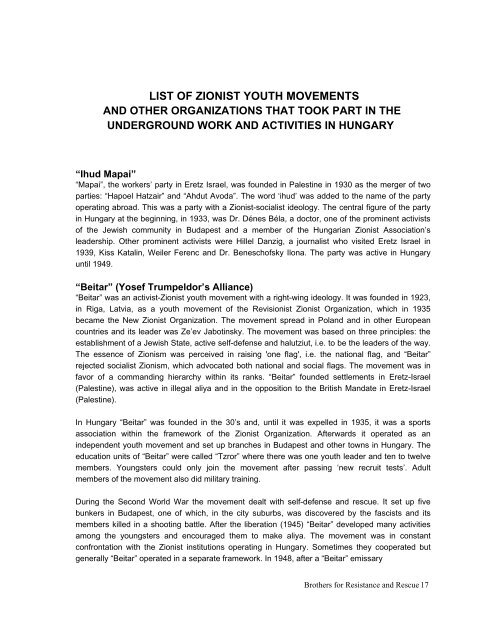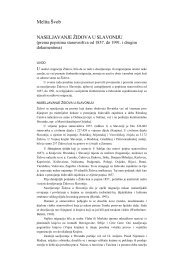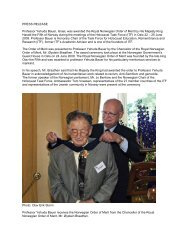Brothers for Resistance and Rescue 1 - CENDO
Brothers for Resistance and Rescue 1 - CENDO
Brothers for Resistance and Rescue 1 - CENDO
You also want an ePaper? Increase the reach of your titles
YUMPU automatically turns print PDFs into web optimized ePapers that Google loves.
LIST OF ZIONIST YOUTH MOVEMENTS<br />
AND OTHER ORGANIZATIONS THAT TOOK PART IN THE<br />
UNDERGROUND WORK AND ACTIVITIES IN HUNGARY<br />
“Ihud Mapai”<br />
“Mapai”, the workers’ party in Eretz Israel, was founded in Palestine in 1930 as the merger of two<br />
parties: “Hapoel Hatzair” <strong>and</strong> “Ahdut Avoda”. The word ‘ihud’ was added to the name of the party<br />
operating abroad. This was a party with a Zionist-socialist ideology. The central figure of the party<br />
in Hungary at the beginning, in 1933, was Dr. Dénes Béla, a doctor, one of the prominent activists<br />
of the Jewish community in Budapest <strong>and</strong> a member of the Hungarian Zionist Association’s<br />
leadership. Other prominent activists were Hillel Danzig, a journalist who visited Eretz Israel in<br />
1939, Kiss Katalin, Weiler Ferenc <strong>and</strong> Dr. Beneschofsky Ilona. The party was active in Hungary<br />
until 1949.<br />
“Beitar” (Yosef Trumpeldor’s Alliance)<br />
“Beitar” was an activist-Zionist youth movement with a right-wing ideology. It was founded in 1923,<br />
in Riga, Latvia, as a youth movement of the Revisionist Zionist Organization, which in 1935<br />
became the New Zionist Organization. The movement spread in Pol<strong>and</strong> <strong>and</strong> in other European<br />
countries <strong>and</strong> its leader was Ze’ev Jabotinsky. The movement was based on three principles: the<br />
establishment of a Jewish State, active self-defense <strong>and</strong> halutziut, i.e. to be the leaders of the way.<br />
The essence of Zionism was perceived in raising 'one flag', i.e. the national flag, <strong>and</strong> “Beitar”<br />
rejected socialist Zionism, which advocated both national <strong>and</strong> social flags. The movement was in<br />
favor of a comm<strong>and</strong>ing hierarchy within its ranks. “Beitar” founded settlements in Eretz-Israel<br />
(Palestine), was active in illegal aliya <strong>and</strong> in the opposition to the British M<strong>and</strong>ate in Eretz-Israel<br />
(Palestine).<br />
In Hungary “Beitar” was founded in the 30’s <strong>and</strong>, until it was expelled in 1935, it was a sports<br />
association within the framework of the Zionist Organization. Afterwards it operated as an<br />
independent youth movement <strong>and</strong> set up branches in Budapest <strong>and</strong> other towns in Hungary. The<br />
education units of “Beitar” were called “Tzror” where there was one youth leader <strong>and</strong> ten to twelve<br />
members. Youngsters could only join the movement after passing ‘new recruit tests’. Adult<br />
members of the movement also did military training.<br />
During the Second World War the movement dealt with self-defense <strong>and</strong> rescue. It set up five<br />
bunkers in Budapest, one of which, in the city suburbs, was discovered by the fascists <strong>and</strong> its<br />
members killed in a shooting battle. After the liberation (1945) “Beitar” developed many activities<br />
among the youngsters <strong>and</strong> encouraged them to make aliya. The movement was in constant<br />
confrontation with the Zionist institutions operating in Hungary. Sometimes they cooperated but<br />
generally “Beitar” operated in a separate framework. In 1948, after a “Beitar” emissary<br />
<strong>Brothers</strong> <strong>for</strong> <strong>Resistance</strong> <strong>and</strong> <strong>Rescue</strong> 17




